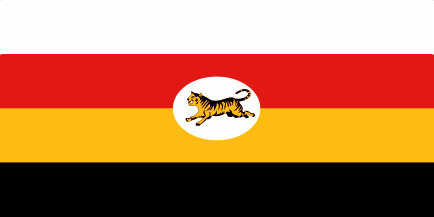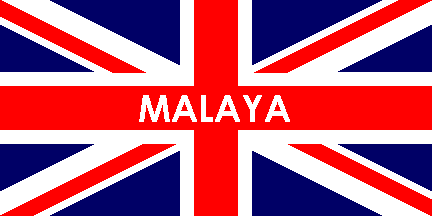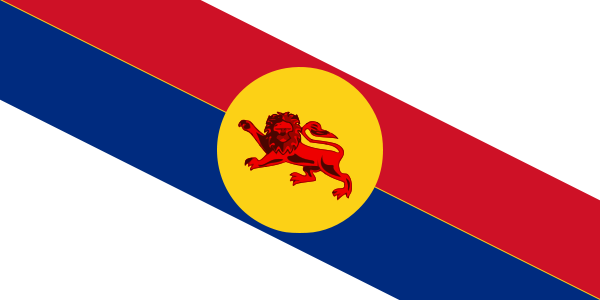The Malayan Union was the successor to British Malaya in order to unify all the different states in the Malay Peninsular, apart from Singapore, under one government. Under this new administration, Malaya would become a Crown Colony under a British Governor with the Malay rules conceding all their powers to the British Crown except in religious affairs.The political status of the Malay rulers were reduced with British Residents replacing them as the head of the State Councils. Although, the State Councils for each state was maintained, they lost their limited autonomy as they became merely an extension of the Federal government. After protests from nationalist groups, the Union was modified into the Federation of Malaya, which still excluded Singapore and restored most of the Malay rulers' power.
This was the proposed country which would have included Singapore into Malaya again. It was first proposed when the British worked together with the aristocracy and conservatives to form the Anglo-Malay Proposals which further polarized the different ethnic groups in Malaya, restricted citizenship to non-natives, separated Singapore from the rest of Malaya and delayed independence. The All-Malaya Council of Joint Action, which comprised of various left-winged anti-colonial political groups from the moderate Malayan Democratic Union and Malay Nationalist Party to the radical Malayan Communist Party, proposed an alternative People's Constitution that would combat all of these issues. Despite having organized a successful protest called the All-Malayan Hartal, the British ignored the Council's demands and began to ban all left wing organizations following the armed rebellion of the Communist Party and the eventual declaration of the Malayan Emergency. By then, the Federation of Malaya was put into action and Singapore would be forever politically separated from the rest of the country.
3) People's Democratic Republic of Malaya
After the British ignored the All-Malaya Council of Joint Action's People's Constitution, the Malayan Communist Party revived its military wing, the Malayan Peoples' Anti-Japanese Army. Originally a resistance movement worked with the British to fight the Japanese during World War II, it was renamed the Malayan Races Liberation Army and declared the Anti-British National Liberation War, which the British called the Malayan Emergency. The Malayan Communist Party intended to form a Communist republic in Malaya by which included Singapore. During the Baling Talks, the Communist Party proposed the government to recognize it as a legitimate political party, which was refused. Following its declining influence and power, the concept of the People's Democratic Republic of Malaya eventually died out.
3. Johore
Before independence, the Anglophile Sultan Ibrahim of Johor was uncomfortable with his state being part of the Federation of Malaya. He wrote to The Straits Times in 1953 voicing his doubts on Johor's future as part of an independent Malaya. He supported the continuation of Johor as an independent British protectorate with its own British Adviser.The Sultan's supporters soon formed a secessionist movement called Persatuan Kebangsaan Melayu Johor (PKMJ) with the Sultan's relative, Ungku Abdullah bin Omar as its president. However, the Alliance Party's influence under Tunku Abdul Rahman's leadership proved to be too powerful, and Sultan Ibrahim moved to London, leaving behind crown prince Tunku Ismail as regent. Ungku Abdullah urged Tunku Ismail to not sign the Malayan Federal Constitution but was ignored. Tunku Abdul Rahman then invited Sultan Ibrahim to become the first Yang di-Pertuan Agong of Malaysia, but the Sultan declined allegedly due to old age and his wish to spend his final years in retirement. With most of his party members crossing over to the Alliance, Ungku Abdullah disbanded his party before independence. Had Tunku Ismail not sign the Constitution, Johor would not have become part of Malaya and even Malaysia.
Indonesia Raya was a concept that intended to unite all races with Malay roots by merging together the British territories in the Malay Peninsular, Borneo and the Dutch East Indies. It was first proposed in the late 1920s by graduates and students of the famous Sultan Idris Teacher Training College but was forgotten after the Japanese Occupation. In the 1950s, important Indonesian figures such as Sukarno and Muhammad Yamin strongly opposed the formation Malaysia, terming it a British puppet state to reestablish neo-colonialism in Southeast Asia to hamper the growth of Indonesia. This hostile political stance led to the Indonesia–Malaysia Confrontation. The fall of Sukarno and the rise of General Suharto finally led to peace between the two nations, with both acknowledging each other's sovereignty.
The North Borneo Federation was a proposed post-decolonization alternative which would have made up of British Sarawak, British North Borneo (now Sabah) and the British protectorate of Brunei. Originally proposed by Brunei's People Party president, A. M. Azahari, he was seeking the unification of all Borneo territories under British rule to form an independent leftist North Kalimantan state with the Sultan of Brunei as the constitutional monarch. This would make the people of Broneo strong enough to resist Malay political domination and Chinese economical domination. After the failed Brunei Revolt, the proposed country died out. The Sultanate of Brunei was more in favour of joining Malaysia than forming the North Borneo Federation. However, disagreements regarding the Sultan's seniority in succession as Agong and disputes over oil royalties prevented Brunei from joining Malaysia.
7. Prince of Wales Island
Before independence, the Straits Chines in Penang initiated an active secessionist movement as they associated themselves more with the British rather than the Malays of the mainland. The term 'pendatang' or 'foreigners' often used to refer to their community especially offended them since they were mostly born in Penang and saw the island as their home. They first made their voiced heard in the 1940s during the proposal to amend the Banishment Ordinance, which would allow the government to banish those born in the Straits Settlements to their ancestral homeland. However, the secessionist movement eventually died out following the Malayan Emergency when the British started to ban all left-winged movements in an attempt to combat Communism.






.svg/250px-Flag_of_Penang_(1946-1949).svg.png)
No comments:
Post a Comment